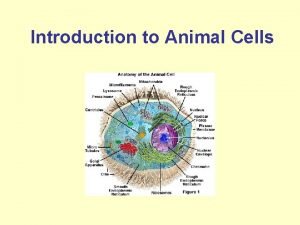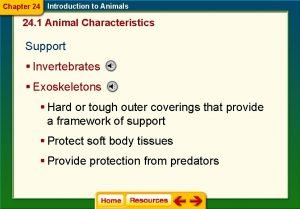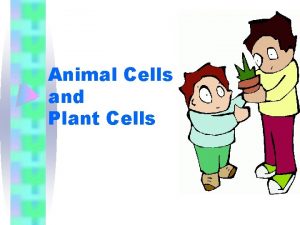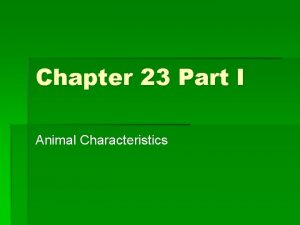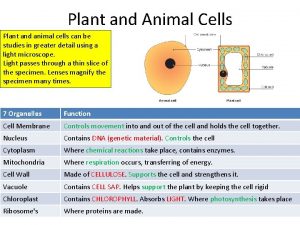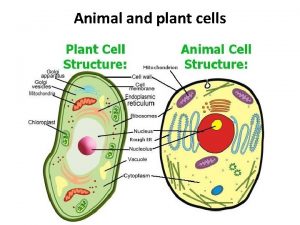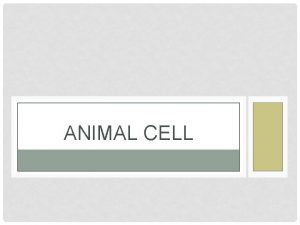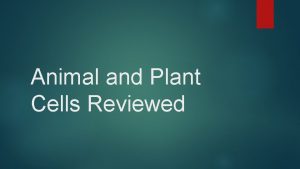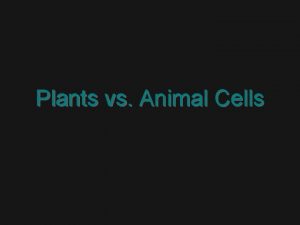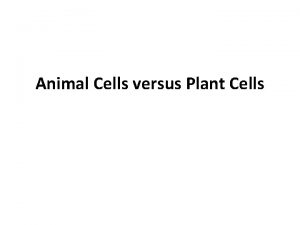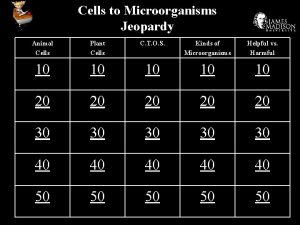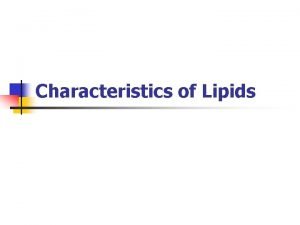Introduction to Animal Cells Characteristics of Animal Cells

















- Slides: 17

Introduction to Animal Cells

Characteristics of Animal Cells • They are eukaryotic cells, that means they contain a membrane bound nucleus • They lack a cell wall that plant cells have • Generally they are larger and more complex than prokaryotic cells • Contains membrane bound structures called organelles

Plasma Membrane • Not an organelle • Selectively permeable • Defines boundaries of cell and ensures contents are retained • Made of proteins and lipids – Phospholipid bilayer

Nucleus • Considered the “Control Center” of the cell • Controls cell activity • Contains nearly all of the cell’s DNA

Nucleolus • Small, dense region within the nucleus • The beginning site of protein assembly

Nuclear Envelope • • Double membrane that surrounds nucleus Protects and isolates cell DNA Selectively permeable Contains thousands of nuclear pores that allow material to move into and out of the cell

Centrioles • Located near the nucleus • Help to organize cell division in animal cells

Ribosomes • Most numerous and smallest organelle • Composed of RNA and proteins • Found throughout cytoplasm and attached to Rough Endoplasmic Reticulum • Site of protein synthesis • Made of 2 subunits

Endoplasmic Reticulum (ER) • Site where lipid components of cell membrane and proteins are assembled • Site of preparation of material to be exported from the cell • Two types – Rough ER – Smooth ER

Endoplasmic Reticulum cont. • Rough ER • Smooth ER – Has ribosomes attached to surface – Portion of ER involved in protein synthesis – Lacks ribosomes – Contains enzymes that are specialized detoxify drugs and synthesize membrane lipids

Golgi Apparatus • Site of protein processing, sorting, packing, and transport from ER to be secreted from the cell

Mitochondria • One of the largest organelles • Breaks down sugar molecules stored in food and converts them to chemical energy for use by the cell (ATP) • Contain their own DNA, RNA, and ribosomes and are able to reproduce themselves

Mitochondria • The “powerhouse” of the cell cont

Lysosomes & Peroxisomes • Similar in both structure and function • Lysosomes – Filled with enzymes to breakdown and digest dead organelles and proteins not being used • Peroxisomes – Detoxifies hydrogen peroxide and other harmful compounds – Plays a part in the oxidative breakdown of fatty acids in animal cells

Vacuoles • Saclike structure • Storage area for the cell • Stores materials like water, salt, proteins and carbohydrates

Cytoskeleton • Network of protein filaments that help cell maintain its shape • Involved in movement of cells

 Plant animal cell venn diagram
Plant animal cell venn diagram Characteristics of the animal cell
Characteristics of the animal cell Chapter 24 section 1 animal characteristics
Chapter 24 section 1 animal characteristics Olfactory groove keros classification
Olfactory groove keros classification Dr saja
Dr saja Parafollicular cells vs follicular cells
Parafollicular cells vs follicular cells Haploid and diploid venn diagram
Haploid and diploid venn diagram Somatic cells vs germ cells
Somatic cells vs germ cells Chlorocruorin
Chlorocruorin Prokaryote vs eukaryote worksheet
Prokaryote vs eukaryote worksheet Prokaryotic cells vs eukaryotic cells venn diagram
Prokaryotic cells vs eukaryotic cells venn diagram The organelle trail
The organelle trail Masses of cells form and steal nutrients from healthy cells
Masses of cells form and steal nutrients from healthy cells Pseudostratified vs simple columnar
Pseudostratified vs simple columnar Cuál es la diferencia entre la célula animal y vegetal
Cuál es la diferencia entre la célula animal y vegetal Prokaryotic cells vs eukaryotic cells
Prokaryotic cells vs eukaryotic cells Nondisjunction in meiosis
Nondisjunction in meiosis Cell substance
Cell substance

